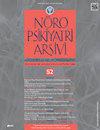光敏性癫痫临床与脑电图表现与GABA受体α 1亚基(GABRA1)基因突变关系的研究
IF 1.1
4区 医学
Q4 CLINICAL NEUROLOGY
引用次数: 1
摘要
目的:光敏性癫痫虽常见,但其病理生理机制尚不明确。然而,相关文献表明遗传因素起着重要的作用。我们的目的是通过扫描GABA受体α 1亚基(GABRA1)基因,探讨PE患者的临床和脑电图(EEG)特征与GABA受体α 1亚基(GABRA1)基因可能的突变/多态性之间是否存在关系。方法:根据国际抗癫痫联盟(ILAE)标准诊断为PE的患者54例纳入研究。分析患者的性别、临床和综合征特征、对治疗的反应、脑电图特征和光阵发性反应(PPR)类型。采用变性高效液相色谱(DHPLC)对GABRA1基因的所有外显子进行突变筛选。结果:PE患者未检测到GABRA1基因突变。GABRA1基因存在4个单核苷酸多态性(snp),但均与氨基酸变化无关。此外,在将存在这些snp的患者与其余无snp的患者进行临床和脑电图特征比较时,我们未发现GABRA1基因有统计学差异。结论:GABRA1基因缺乏突变表明该基因并不主要参与土耳其人群PE的发病机制。为了获得更精确的证据,应该通过增加患者数量和研究与GABA相关的其他基因来扩展研究。(《神经精神病学档案》2011;48: 39-43)本文章由计算机程序翻译,如有差异,请以英文原文为准。
Investigation of the Relationship Between Clinical and EEG Findings of Photosensitive Epilepsy and GABA Receptor Alpha 1 Subunit (GABRA1) Gene Mutations
Objective: Although photosensitive epilepsy (PE) is commonly observed, its pathophysiology has not been clarified yet. However, relevant literature indicates that genetic factors play an important role. Our aim was to investigate whether there is a relationship between the clinical and electroencephalographic (EEG) features and the possible mutations/polymorphisms in the GABA receptor alpha 1 subunit (GABRA1) gene in patients with PE by scanning this gene. Methods: 54 patients diagnosed as having PE according to International League Against Epilepsy (ILAE) criteria were included in the study. The patients were analyzed in terms of gender, clinical and syndromic features, response to treatment, EEG features, and photoparoxysmal response (PPR) types. Mutation screening was done by denaturing high-performance liquid chromatography (DHPLC) on all exons belonging to GABRA1 gene. Results: We could not detect any mutation in GABRA1 gene in patients with PE. Four single-nucleotide polymorphisms (SNPs) in GABRA1 gene were observed, but none of them were associated with amino acid changes. Besides, when comparing the patients having these SNPs with the remaining patients without any SNPs in regard to clinical and EEG features, we were not able to find a statistically significant difference for GABRA1 gene. Conclusion: The lack of mutations in the GABRA1 gene indicates that this gene is not predominantly involved in the etiopathogenesis of PE in the Turkish population. In order to get more precise evidence, the research should be extended by increasing the number of patients and by investigating other genes related to GABA. (Archives of Neuropsychiatry 2011; 48: 39-43)
求助全文
通过发布文献求助,成功后即可免费获取论文全文。
去求助
来源期刊

Noropsikiyatri Arsivi-Archives of Neuropsychiatry
CLINICAL NEUROLOGY-
CiteScore
1.70
自引率
9.10%
发文量
0
审稿时长
6-12 weeks
期刊介绍:
Archives of Neuropsychiatry (Arch Neuropsychiatry) is the official journal of the Turkish Neuropsychiatric Society. It is published quarterly, and four editions annually constitute a volume.
Archives of Neuropsychiatry is a peer reviewed scientific journal that publishes articles on psychiatry, neurology, and behavioural sciences. Both clinical and basic science contributions are welcomed. Submissions that address topics in the interface of neurology and psychiatry are encouraged. The content covers original research articles, reviews, letters to the editor, and case reports.
 求助内容:
求助内容: 应助结果提醒方式:
应助结果提醒方式:


